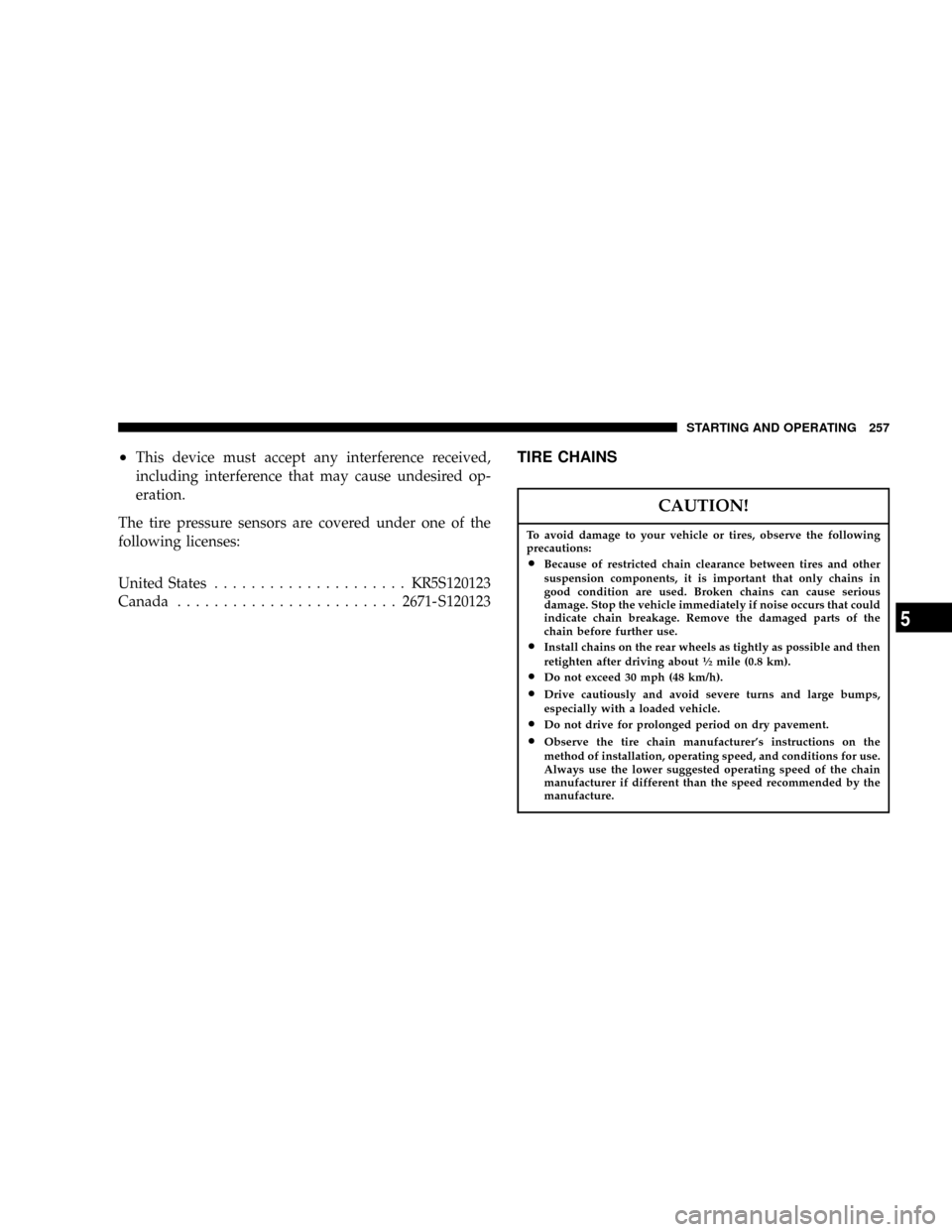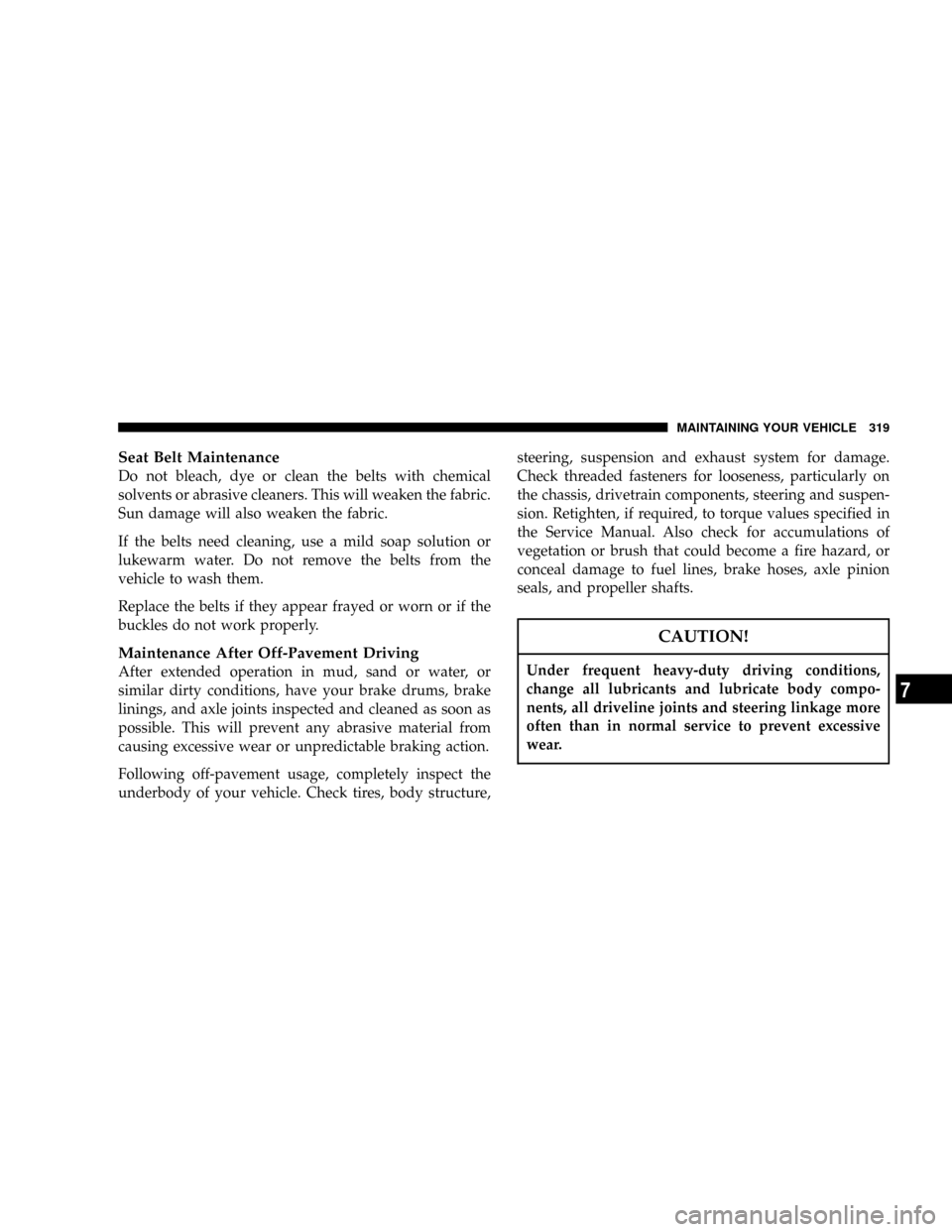Page 257 of 374

²This device must accept any interference received,
including interference that may cause undesired op-
eration.
The tire pressure sensors are covered under one of the
following licenses:
United States.....................KR5S120123
Canada........................2671-S120123TIRE CHAINS
CAUTION!
To avoid damage to your vehicle or tires, observe the following
precautions:
²Because of restricted chain clearance between tires and other
suspension components, it is important that only chains in
good condition are used. Broken chains can cause serious
damage. Stop the vehicle immediately if noise occurs that could
indicate chain breakage. Remove the damaged parts of the
chain before further use.
²Install chains on the rear wheels as tightly as possible and then
retighten after driving about1¤2mile (0.8 km).
²Do not exceed 30 mph (48 km/h).
²Drive cautiously and avoid severe turns and large bumps,
especially with a loaded vehicle.
²Do not drive for prolonged period on dry pavement.
²Observe the tire chain manufacturer's instructions on the
method of installation, operating speed, and conditions for use.
Always use the lower suggested operating speed of the chain
manufacturer if different than the speed recommended by the
manufacture.
STARTING AND OPERATING 257
5
Page 258 of 374

Tire chains that are recommended for this vehicle are
listed below:
²MopartP/N 82206828 with P235/70R16 and P235/
65R17 tires.
²MopartP/N 82207074 with P215/75R16 tires.
NOTE:In order to avoid damage to tires, chains, and
your vehicle do not drive for a prolonged period of time
on dry pavement. Observe the tire chain manufacturer's
instructions on method of installation, operating speed,
and conditions for usage.
Always use the lower suggested operating speed if both
the chain manufacturer and vehicle manufacturer sug-
gest a maximum speed. This notice applies to all chain
traction devices, including link and cable (radial) chains.
TIRE ROTATION RECOMMENDATIONS
Tires on the front and rear axles of vehicles operate at
different loads and perform different steering, handling,
and braking functions. For these reasons, they wear at
unequal rates, and develop irregular wear patterns.
These effects can be reduced by timely rotation of tires.
The benefits of rotation are especially worthwhile with
aggressive tread designs such as those on On/Off Road
type tires. Rotation will increase tread life, help to main-
tain mud, snow, and wet traction levels, and contribute to
a smooth, quiet ride.
Follow the recommended tire rotation frequency for your
type of driving found in the ªMaintenance Schedulesº
Section of this manual. More frequent rotation is permis-
sible if desired. The reasons for any rapid or unusual
wear should be corrected prior to rotation being per-
formed.
258 STARTING AND OPERATING
Page 274 of 374
CHANGING A FLAT TIRE
Jack And Lug Wrench Locations
The jack, jack handle, and lug wrench are stored beneath
the right rear seat. To remove the jack from its stowage
position, turn the thumb screw counterclockwise to
loosen jack assembly and then remove it.
WARNING!
²Always store the jack, lug wrench and spare, flat
or damaged tire securely in the proper place.
Never leave them loose in the vehicle where they
could become dangerous projectiles during a
quick stop or collision.
²The jack is designed to use as a tool for changing
tires only. The jack should not be used to lift the
vehicle for service purposes, unless suitable sup-
ports are placed under the vehicle as a safety
measure. The vehicle should be jacked on a firm
level surface only. Avoid ice or slippery areas.
274 WHAT TO DO IN EMERGENCIES
Page 276 of 374
Preparation
²
Park on a firm, level surface well off the road, to
provide ample work space. Place automatic transmis-
sion in P (Park), or manual transmission in R (Re-
verse), and stop engine. Set parking brake firmly and
activate hazard warning flasher.
²Block tire diagonally oppo-
site tire to be changed to pre-
vent forward and backward
vehicle movement.
Instructions
1. Remove spare tire, jack and tools from stored location.
2. Before raising vehicle, loosen lug nuts on wheel with
flat tire.3. Assemble the jack and jacking tools as shown. Connect
jack handle driver to extensions, then to lug wrench.
4. Locate the jack as shown. For the front tires, place it in
the notch on the body weld seam behind wheel to be
changed. For the rear tires, place it under the axle as
shown. Position the jack handle on the jack.
Front Scissor Jack Location
276 WHAT TO DO IN EMERGENCIES
Page 319 of 374

Seat Belt Maintenance
Do not bleach, dye or clean the belts with chemical
solvents or abrasive cleaners. This will weaken the fabric.
Sun damage will also weaken the fabric.
If the belts need cleaning, use a mild soap solution or
lukewarm water. Do not remove the belts from the
vehicle to wash them.
Replace the belts if they appear frayed or worn or if the
buckles do not work properly.
Maintenance After Off-Pavement Driving
After extended operation in mud, sand or water, or
similar dirty conditions, have your brake drums, brake
linings, and axle joints inspected and cleaned as soon as
possible. This will prevent any abrasive material from
causing excessive wear or unpredictable braking action.
Following off-pavement usage, completely inspect the
underbody of your vehicle. Check tires, body structure,steering, suspension and exhaust system for damage.
Check threaded fasteners for looseness, particularly on
the chassis, drivetrain components, steering and suspen-
sion. Retighten, if required, to torque values specified in
the Service Manual. Also check for accumulations of
vegetation or brush that could become a fire hazard, or
conceal damage to fuel lines, brake hoses, axle pinion
seals, and propeller shafts.
CAUTION!
Under frequent heavy-duty driving conditions,
change all lubricants and lubricate body compo-
nents, all driveline joints and steering linkage more
often than in normal service to prevent excessive
wear.
MAINTAINING YOUR VEHICLE 319
7
Page 332 of 374
At Each Oil Change
²Change the engine oil filter.
²Inspect the exhaust system.
²Inspect brake hoses.
²Check the coolant level, hoses, and clamps.
²Inspect manual transmission fluid level Ð if
equipped.
²Rotate the tires at each oil change interval shown on
Schedule ªAº 6,000 miles (10 000 km) or every other
interval shown on Schedule ªBº 6,000 miles (10 000
km).
²After completion of off-road operation, the underside
of the vehicle should be thoroughly inspected. Exam-
ine threaded fasteners for looseness.
332 MAINTENANCE SCHEDULES
8
M
A
I
N
T
E
N
A
N
C
E
S
C
H
E
D
U
L
E
S
Page 358 of 374

Adding Washer Fluid..................... 204
Air Cleaner, Engine...................... 297
Air Conditioner Maintenance............... 299
Air Conditioning........................ 200
Air Conditioning Controls...............200,201
Air Conditioning, Operating Tips............ 202
Air Conditioning Refrigerant............... 300
Air Conditioning System.................. 200
Air Filter.............................. 297
Air Pressure, Tires....................... 249
Airbag................................ 46
Airbag Deployment....................... 55
Airbag Light.......................51,58,157
Airbag Maintenance....................... 57
Airbag, Window......................... 47
Alarm................................ 28
Alarm, Panic............................ 25
Alignment and Balance................... 253
Alterations/Modifications, Vehicle............. 8Antenna, Satellite Radio................... 193
Antifreeze (Engine Coolant)................ 326
Anti-Lock Brake System................... 234
Anti-Lock Warning Light.................. 152
Appearance Care........................ 315
Arming Theft System...................... 28
Auto Down Power Windows................ 33
Automatic Dimming Mirror................. 76
Automatic Door Locks..................... 21
Automatic Transmission................216,311
Adding Fluid......................... 312
Fluid and Filter Changes................. 311
Fluid Level Check...................... 311
Fluid Type........................... 311
Gear Ranges.......................... 217
Shifting............................. 216
Special Additives...................... 312
Torque Converter...................... 221
Auxiliary Electrical Outlet.................. 133
358 INDEX
Page 364 of 374

Gauges
Coolant Temperature.................... 153
Fuel................................ 157
Odometer........................... 154
Speedometer......................... 151
Tachometer.......................... 151
Gear Ranges........................215,217
General Information...................... 256
Glass Cleaning.......................... 318
Glove Compartment...................... 135
Hands-Free Phone........................ 78
Hazard Warning Flasher................... 272
Head Restraints.......................... 92
Head Rests............................. 92
Headlights............................ 101
High Beam........................... 151
Lights On Reminder.................... 102
Passing............................. 101Switch.............................. 101
Heated Mirrors.......................... 78
Heated Seats............................ 97
Heater............................... 198
Heater, Engine Block..................... 212
Holder, Cup........................... 136
Homelink Transmitter.................... 125
Hood Release........................... 97
Hoses................................ 307
Hydraulic Clutch Fluid.................... 313
Identifying Your Engine................285,286
Ignition
Key ................................. 12
Wiring System........................ 297
Illuminated Entry........................ 17
Inflation Pressure Tires.................... 249
Information Center, Vehicle................. 112
Inside Rearview Mirror.................... 75
364 INDEX